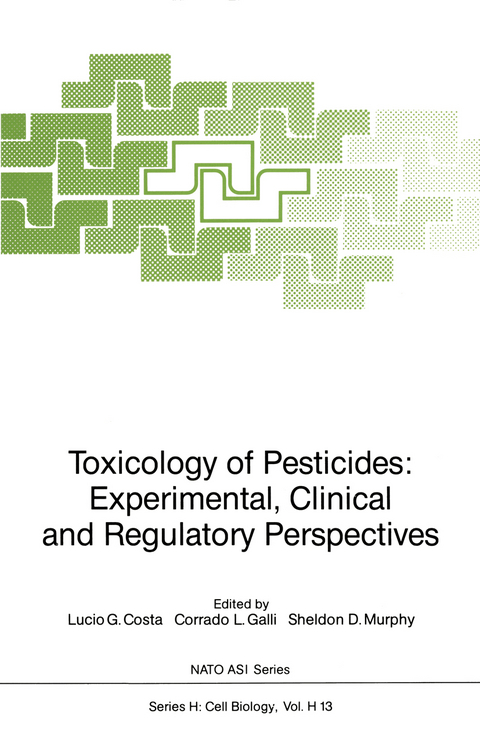
Toxicology of Pesticides
Springer Berlin (Verlag)
978-3-642-70900-5 (ISBN)
The protection of human health and food and fiber resources against the ravages of pests of many sorts is a continuous struggle by all people in the world. The use of chemical pesticides as an aid in this struggle is now also global. These chemicals are deliberately added to the environment for the purpose of killing or injuring some form of life. Because pesticides are generally less selectively toxic than would be desired, non-target species, including humans, must be protected from injury by these chemicals. This can only be achieved by thorough understanding of the comparative toxicology of these compounds, and by minimizing human (and other desirable species) exposure. The latter can only be achieved by sound regulatory policies that utilize scientific principles and data, properly tempered by both gaps in that data and sociologic and economic considerations. This book contains the proceedings of the NATO Advanced Study Institute on "Toxicology of Pesticides: Experimental, Clinical and Regulatory Perspectives" held in Riva del Garda on October 6-15, 1986. This NATO-ASI has been promoted by the School of Public Health and Community Medicine, University of Washington at Seattle, by the Institute of Pharmacological Sciences, University of Milano and by the Giovanni Lorenzini Foundation, and has been sponsored by both the Society of Toxicology (USA) and the Italian Society of Toxicology.
Toxicology of Pesticides: A Brief History.- Production and Use of Pesticides.- Role of Metabolism in Pesticide Selectivity and Toxicity.- Toxicology of Organophosphates and Carbamates.- Toxicology of Chlorophenoxy Herbicides and their Contaminants.- Reactive Oxygen Species and Cell Injury: Role in Pesticide Toxicity.- Interaction of Insecticides with the Nervous System.- The Role of Genetic Differences in Human Susceptibility to Pesticides.- The Reproductive Toxicology of Pesticides.- Carcinogenicity of Pesticides.- Dermal Toxicity of Pesticides.- Environmental Distribution and Fate of Pesticides. A Predictive Approach.- Ecotoxicology of Pesticides: The Laboratory and Field Evaluation of the Environmental Hazard Presented by New Pesticides.- Clinical Management of Pesticide Poisoning.- Assessment of Human Exposure to Pesticides.- Pesticides - Risk Assessment and Safe Use.- Role of Biotechnology in Pesticide Development: Bacillus Thuringiensis as an Example.- Pesticide Use Exposure and Regulation in Developed and Developing Countries.- Species Differences in Serum Paraoxonase Correlate with Sensitivity to Paraoxon Toxicity.- The Effects of Pyrethroid Insecticides on Synaptic Transmission in Slices of Guinea Pig Olfactory Cortex.- Critical Review of Pesticide-Related Alimentary Outbreaks.- Peripheral and Central Enzyme Inhibition by Fenthion, Fenitrothion and Desbromoleptophos.- Application of Structure-Activity Analysis for Estimation of Potential Effects of Pesticides on Environmental Biological Targets.- Decrements in Retrograde Axonal Transport Precede Onset of Nerve Fiber Degeneration in Organophosphate Neuropathy.- The Lungs as a Target for the Toxicity of Some Organophosphorus Compounds.- Behavioral and Biochemical Effects of Early Postnatal Parathion Exposure inthe Rat.- Effects of Lindane on Central Nervous System: Behavioural Studies.
| Erscheint lt. Verlag | 17.11.2011 |
|---|---|
| Reihe/Serie | Nato ASI Subseries H: |
| Zusatzinfo | IX, 320 p. |
| Verlagsort | Berlin |
| Sprache | englisch |
| Maße | 170 x 244 mm |
| Gewicht | 580 g |
| Themenwelt | Naturwissenschaften ► Biologie ► Ökologie / Naturschutz |
| Schlagworte | Biotechnology • Contaminants • ecotoxicology • Environment • environmental distribution • insecticide • insecticides • Metabolism • organophosphorus • Pesticide • Pesticides • risk assessment • Toxicity • Toxicology • Transport |
| ISBN-10 | 3-642-70900-1 / 3642709001 |
| ISBN-13 | 978-3-642-70900-5 / 9783642709005 |
| Zustand | Neuware |
| Haben Sie eine Frage zum Produkt? |
aus dem Bereich


